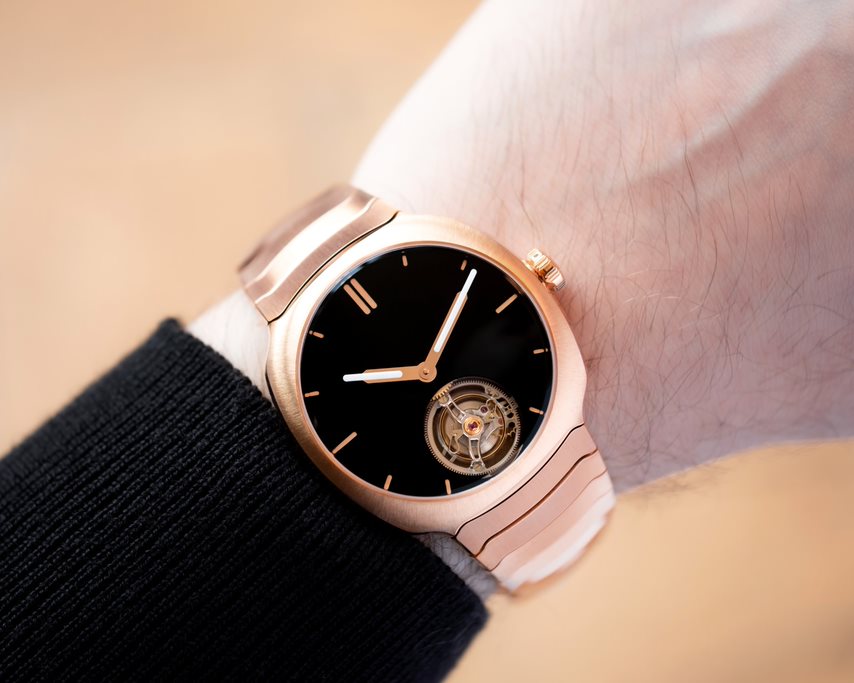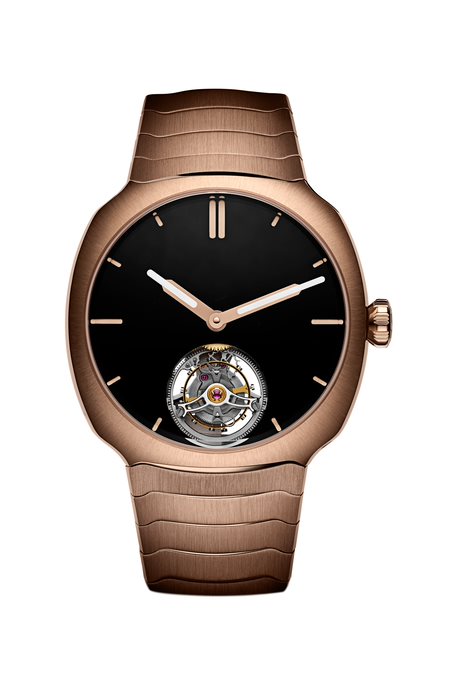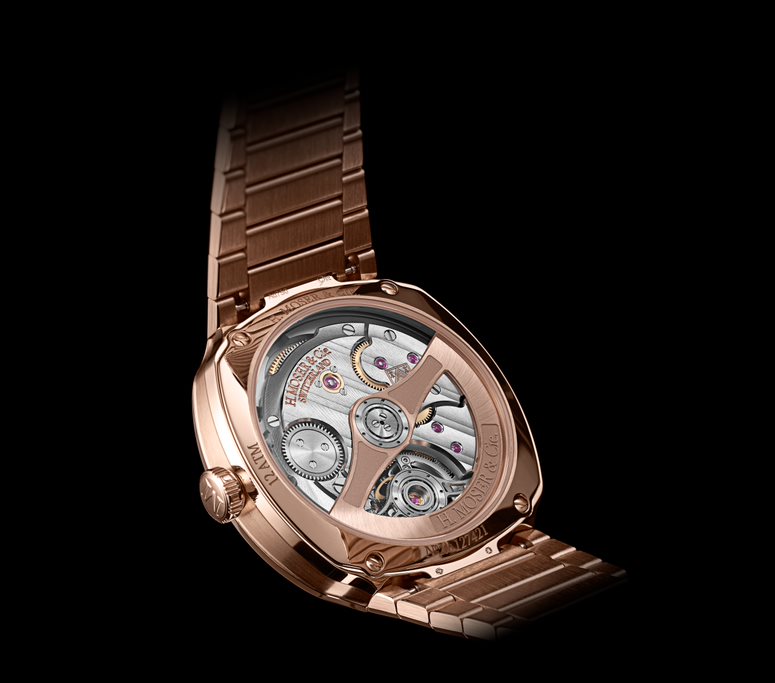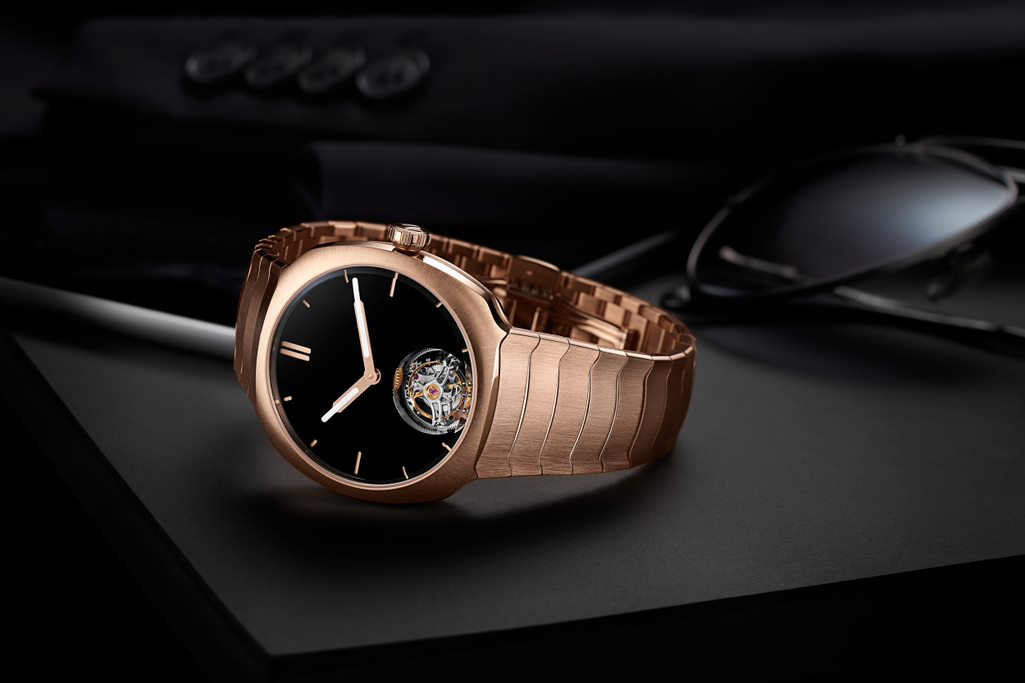
H. Moser & Cie Streamliner Tourbillon Vantablack® 18-karat gold watch
For those in the watchmaking know, the use of Vantablack® is relatively new. Not only that, but combining this high-tech ultra-black substance with precious materials like 18-karat gold is also not the norm. But then independent Swiss watch brand H. Moser & Cie. is anything but normal. This brand is all about stepping outside the proverbial box and shaking the world up with its extremes. It did just that with a host of concept watches and with the vintage-styled Streamliner that it first unveiled in early 2020 that met with a lot of raised eyebrows. Now it does it again with the Streamliner Tourbillon Vantablack® 18-karat gold watch.

H. Moser & Cie Streamliner Tourbillon Vantablack® 18-karat gold watch retails for $119,900.
Vantablack®, which gets its name from the acronym VANTA — vertically aligned nano tube arrays (carbon nano tubes) — is said to absorb more than 99.9 percent of light so that the substance seen is the blackest black in the world. It was first used in 2016 in watchmaking by MCT, a now defunct independent brand.
It was showcased again in 2019—as an April Fool’s joke from none other than H. Moser & Cie. The brand has been known for creating watches for the famed “fooled me” date, but the original mocked up image it put on social media on April 1, 2019, featured a Vantablack® dial and nearly invisible black hands. It was devoid of anything else, including the H. Moser & Cie logo – causing quite a stir. In fact, the brand received requests from loyal followers and so pursued the concept – trying to bring it to reality.

H. Moser & Cie Streamliner Tourbillon Vantablack® 18-karat gold watch with nanotubes of Vantablack, the blackest black.
In 2020, the first H. Moser Vantablack® watches made their appearance on the scene with black hands, as well. There was a white gold Venturer model, steel version and an Endeavour Tourbillon in black DLC coated case with flying tourbillon at 6:00. The stealth-looking watches were a hit. That same year, the brand released its first Streamliner watch in stainless steel with cushion-cornered case edges and integrated bracelet. That watch had collectors doing a double take, as well. But it became a hot topic of conversation (and sales).
Now, H. Moser combines the best of the year of 2020 in a collection geared for 2022 and beyond: the Streamliner Tourbillon Vantablack®. It is a real beauty and is probably a perfect blend of yesteryear (especially given the styling of the watch and the use of 18-karat gold) and tomorrow (thanks to the Vantablack® dial). The thing is this watch is the first Streamliner Tourbillon in 18-karat gold with a Vantablack® dial and is the first of its kind of dial to incorporate full-sized indexes (gold hued) and gold-hued hands with Globolight® inserts. It also boasts the open aperture at 6:00 for viewing the exquisite flying tourbillon escapement (this compensates for the effects of gravity when the watch is in different positions on the wrist).

The movement is visible via the sapphire case back.
Because the Vantablack® dial is actually created of thousands of tiny nanotubes, creating a watch with indexes or markers was no easy feat. In fact, it was one of the biggest challenges the watchmakers faced. If the markers were placed on top of the dial, the highly delicate carbon nanotubes beneath would disintegrate from the pressure. As such, the dial was made with holes formed for the markers. Those markers were then put into place from behind so that they would be flush with the dial. While this was a great solution to a puzzling challenge, it also created an interesting multi-dimensional effect, since the indexes seem to disappear when the watch is viewed from certain angles.
As mentioned, this is the first Streamliner with Vantablack® dial to be crafted in 18-karat 5N rose gold with integrated bracelet and alternating polished and satin-finishes. The allure of the different finishes, with the markers and hands against the all-black dial are a great package, but add to that the constantly rotating flying tourbillon in the automatic HMC 804 mechanical movement and displayed at 6:00 on the dial, and it is an exceptional work of horology and technology. The 40mm watch with domed sapphire crystal is not a limited edition but is limited only by the annual production abilities of H. Moser & Cie. It retails for $119,900.

H. Moser & Cie Streamliner Tourbillon Vantablack® 18-karat gold watch
(This article by Roberta Naas first appeared in her column on Forbes.com.)





